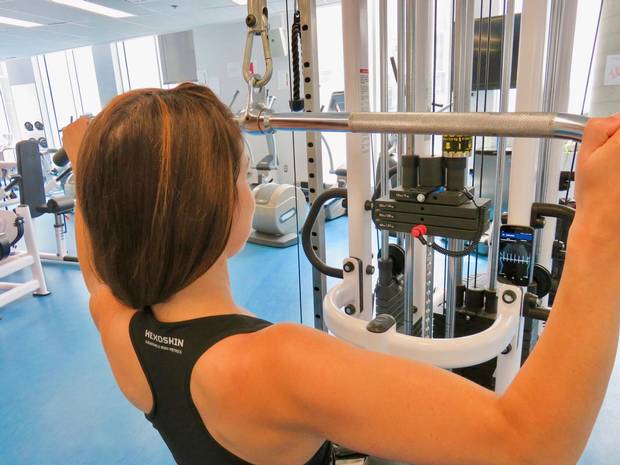At first glance, a Hexoskin Smart shirt looks like basic workout gear – black, wicking fabric sewn into a machine-washable tank or tee with smooth seams, and for women's tops, a built-in bra. But the form-fitting Hexoskin garment developed by Montreal's Carré Technologies is a biometric tool that gathers data, such as the wearer's step count and heart rate, through sensors integrated into the material.
When connected to its Bluetooth recording device, the garment can collect 42,000 data points a minute, making it a scientific instrument at heart, and the perfect tool for professional athletes. The shirts have been worn by Cirque du Soleil's elite performers during rehearsals, as well as the Dufour-Lapointe sisters, Justine, Chloé and Maxime, during their freestyle ski training. Meanwhile, the Hexoskin gear that Canadian gold-medal freestyle wrestler Erica Wiebe wore to train for the Rio de Janeiro Summer Olympics now resides in the permanent collection of Ottawa's Museum of Science and Technology.
But the Hexoskin Smart shirt, which became the first piece of smart clothing sold by Best Buy Canada in 2015, is also at the cutting edge of a fashion industry that is already pushing boundaries, especially when it comes to the fabric itself.

Hexoskin uses sensory wires sewn into the fabric to transmit the wearer’s performance data via Bluetooth.
Hexoskin
For example, when Carré Technologies started production, local manufacturing was a challenge, because of the need to sew the sensory wires into the material. "We had to integrate our technology into the textiles – and people in garment industries don't have experience with electronics," co-founder and chief technology officer Jean-François Roy says. "But we came up with a manufacturing solution that's quite unique, and we're the only ones doing it on Earth. It's our 'secret sauce.'"
Hexoskin, much like other new forms of wearables, looks beyond fashion and gadget trends to blur the line between technology and users, becoming like a second skin for better living. For Canadian innovators in the tech-garment industry, the focus is on wearibility over wearables.
Toronto-based Knix Wear, for example, uses technology to create comfortable intimate apparel. Joanna Griffiths, who founded the company, sources fabric from an Italian textile mill that also supplies Olympic athletic gear. But it's the company's partnership with York University, that's enabled it to undergo explosive growth. The university provides access to state-of-the-art lab equipment, which Knix uses for research and development.
"The innovation piece that we really brought to the table was figuring out the ultimate recipe of the layers," she adds. It's the key to one of the company's newest products, the Evolution tank.
Knix Wear uses technology to create comfortable intimate apparel.
Knix Wear
The Evolution tank "took us two years to develop, to make progress in the internal construction piece and a bonded tank top with no seams," Griffiths explains. "It looks like one component garment but it has six different layers of stabilizers built into it. In the strap, stabilizers mimic the retention and recovery piece of a bra strap."
"I think it's more about what you do with the fabric itself – new applications of fabric innovation that's used in the outdoor industry or the cycling industry, finding ways to bring them into more traditional apparel products," she says.
Meanwhile, for Hamilton, Ont.-raised Greg Dacyshyn, head designer of Burton Snowboards' uniforms for the Canadian National Freestyle Snowboard Team at Pyeongchang, high tech means design innovations in the fabric manufacturing itself. The developments serve the two key functionality goals that enhance a rider's performance, Dacyshyn laughs: "Staying warm and staying dry."
This year, the official Canadian team kit is a mix of what Dacyshyn dubs "analog and digital." The "analog" is a hand-knit wool sweater from B.C.'s Granted that features motifs by artist Corrine Hunt that reflect Komoyue and Tlingit First Nations heritage. The "digital" is sophisticated technical waterproof outerwear featuring Sorona, DuPont's shape memory fabric made from 37-per-cent renewably sourced plant-based ingredients, and a Pertex Quantum shell material that's known for both extreme lightness and tensile strength. "The word cozy is not doing it justice – it's like putting on a sleeping bag that feels like a cocoon. But stronger than steel."
Dacyshyn likens the experiments with fabric technology to building prototype concept cars. "It's a really fun process, there are no barriers and to have the ability to just make things that may not necessarily scale."

The Hexoskin Smart shirt was the first piece of smart clothing sold by Best Buy Canada in 2015.
Hexoskin
Back in Montreal, Roy also evokes an automotive analogy: "We won't build a thousand different kinds of shirts," he says. "It's like the first Ford car. It can be any colour you want, as long as it's black."
While Hexoskin's look like shirts, Roy thinks of them as tools. "We're providing a platform so you can learn about yourself. Sometimes it's using the shirt a couple of months and learning enough that's beneficial." The diagnostic mission comes with different operational usage than, say, counting steps and having an actionable goal to reach every day. Add to that the device is not cheap – about $400 (U.S.) for a starter kit. "It's not for people who run once a week on Sunday," he says.
The company is focused on growth in health research and medical fields such as cardiac and COPD patient rehabilitation. "We would like to make it mainstream so people can use it," Roy says. He hopes to go a step further by helping users interpret the data compiled by the shirt, and so understand their own bodies better. "Everybody can use a shirt, but not everybody can look at their own data, or has the background to analyze what is happening."
Visit tgam.ca/newsletters to sign up for the Globe Style e-newsletter, your weekly digital guide to the players and trends influencing fashion, design and entertaining, plus shopping tips and inspiration for living well. And follow Globe Style on Instagram@globestyle.